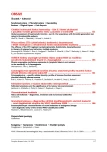Immunophenotypic characterization of acute leukemias of ambiguous lineage - new diagnostic entity of the revised WHO classification 2008
Authors:
I. Marinov 1,2; D. Mikulenková 1; A. Luxová 1; V. Tkáčová 1
Authors‘ workplace:
Ústav hematologie a krevní transfuze
1; Ústav klinické a experimentální hematologie ÚHKT a 1. LF UK, Praha
2
Published in:
Transfuze Hematol. dnes,16, 2010, No. 3, p. 166-171.
Category:
Comprehensive Reports, Original Papers, Case Reports
Overview
Immunophenotyping of leukemic cells by polychromatic flow cytometry is playing an important role in the diagnosis, classification, follow-up of acute leukemias and crucial role in the management of acute leukemias of ambiguous lineage. In the revised WHO classification 2008 the former acute biphenotypic leukemia was renamed mixed phenotype acute leukemia (MPAL) and new definition criteria were established. The aim of the new classification was to simplify existing EGIL scoring system of acute biphenotypic leukemia, to assign lineage as lymphoid or myeloid if possible and to include both biphenotypic and bilineage types. The goal of this article is to approach the new aspects of immunophenotypic characterization of acute leukemias of ambiguous lineage in the context of our own experience.
Key words:
immunophenotyping, flow cytometry, acute leukemias of ambiguous lineage, revised WHO classification 2008
Sources
1. Swerdlow SH, Campo E, Harris NL, et al, eds. WHO Classification of Tumours of Haematopoietic and Lymphoid Tissues. Lyon, France: IARC; 2008.
2. Craig FE, Foon KA. Flow cytometric immunophenotyping for hematologic neoplasms. Blood 2008; 111 : 3941-67.
3. Vardiman JW, Thiele J, Arber DA, et al. The 2008 revision of the World Health Organization (WHO) classification of myeloid neoplasms and acute leukemia: rationale and important changes. Blood 2009; 114 : 937-51.
4. Béné MC, Castoldi G, Knapp W, Ludwig WD, Matutes E, Orfao A, van’t Veer MB. Proposals for the immunological classification of acute leukemias. European Group for the Immunological Characterization of Leukemias (EGIL). Leukemia 1995; 9 : 1783-6.
5. Stetler-Stevenson M, Davis B, Wood B, Braylan R. 2006 Bethesda international consensus conference on flow cytometric immunophenotyping of hematolymphoid neoplasia. Cytometry B Clin Cytom 2007; 72 Suppl 1: S3.
6. Brent L. Wood, Maria Arroz, David Barnett, et al. 2006 Bethesda International Consensus Recommendations on the Immunophenotypic Analysis of Hematolymphoid Neoplasia by Flow Cytometry: Optimal Reagents and Reporting for the Flow Cytometric Diagnosis of Hematopoietic Neoplasia. Cytometry Part B (Clinical Cytometry), 2007; 72B: S14-S22
7. Casasnovas RO, Slimane FK, Garand R, et al. Immunological classification of acute myeloblastic leukemias: relevance to patient outcome Leukemia 2003; 17 : 515-27.
8. Tallman MS. Relevance of pathologic classifications and diagnosis of acute myeloid leukemia to clinical trials and clinical practice. Cancer Treat Res 2004; 121 : 45-67.
9. Nguyen D, Diamond LW, Braylan RC. Flow Cytometry in Hematopathologylogy, Humana Press, 2008.
10. Domingo-Claros A, Larriba I, Rozman M, et al. Acute erythroid neoplastic proliferations. A biological study based on 62 patients. Haematologica 2002; 87 : 148-53.
11. Duchayne E, Fenneteau O, Pages MP, Sainty D, Arnoulet C, Dastugue N, Garand R, Flandrin G; Groupe Francais d’Hematologie Cellulaire; Groupe Francais de Cytogenetique Hematologique. Acute megakaryoblastic leukaemia: a national clinical and biological study of 53 adult and childhood cases by the Groupe Francais d’Hematologie Cellulaire (GFHC). Leuk Lymphoma 2003; 44 : 49-58.
12. Djokic M, Björklund E, Blennow E, Mazur J, Söderhäll S, Porwit A. Overexpression of CD123 correlates with the hyperdiploid genotype in acute lymphoblastic leukemia. Haematologica 2009; 94 : 1016-9.
13. Porwit-MacDonald A, Bjorklund E, Lucio P, et al. BIOMED-1 concerted action report: flow cytometric characterization of CD7+ cellsubsets in normal bone marrow as a basis for the diagnosis and follow-up of Tcell acute lymphoblastic leukemia (T-ALL). Leukemia 2000; 14 : 816-25.
14. Béné MC, Bernier M, Casasnovas RO, et al. Myeloid leukaemia M0: haematological, immunophenotypic and cytogenetic characteristics and their prognostic significance: an analysis in 241 patients. Br J Haematol 2001; 113 : 737-45.
15. Garnache-Ottou F, Feuillard J, Ferrand C, et al. GOELAMS and GEIL study. Extended diagnostic criteria for plasmacytoid dendritic cell leukaemia. Br J Haematol 2009; 145 : 624-36.
16. Klabusay M, Pevná M, Kissová J, Doubek M, Heidekerová M, Mayer J, Vorlíček J. Vzácná diagnóza: CD4+56+ leukemie z dendritických buněk typu DC2. Čas Lék čes 2008; 147(10): 511-515.
Labels
Haematology Internal medicine Clinical oncologyArticle was published in
Transfusion and Haematology Today

2010 Issue 3
Most read in this issue
- Hairy cell leukemia – diagnostics, treatment and monoclonal antibodies
- Follicullar lymphoma and the significance of its tumour microenvironment
- Cytomegalovirus – specific cellular imunity: profile of immune function assesment provides clinically relevant answer
- Immunophenotypic characterization of acute leukemias of ambiguous lineage- new diagnostic entity of the revised WHO classification 2008
